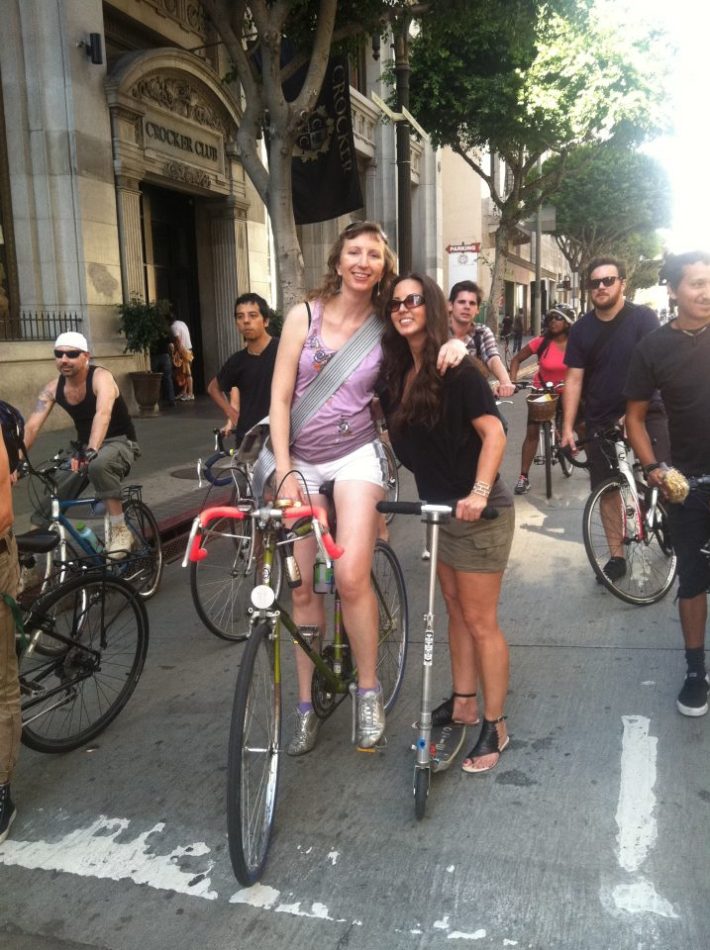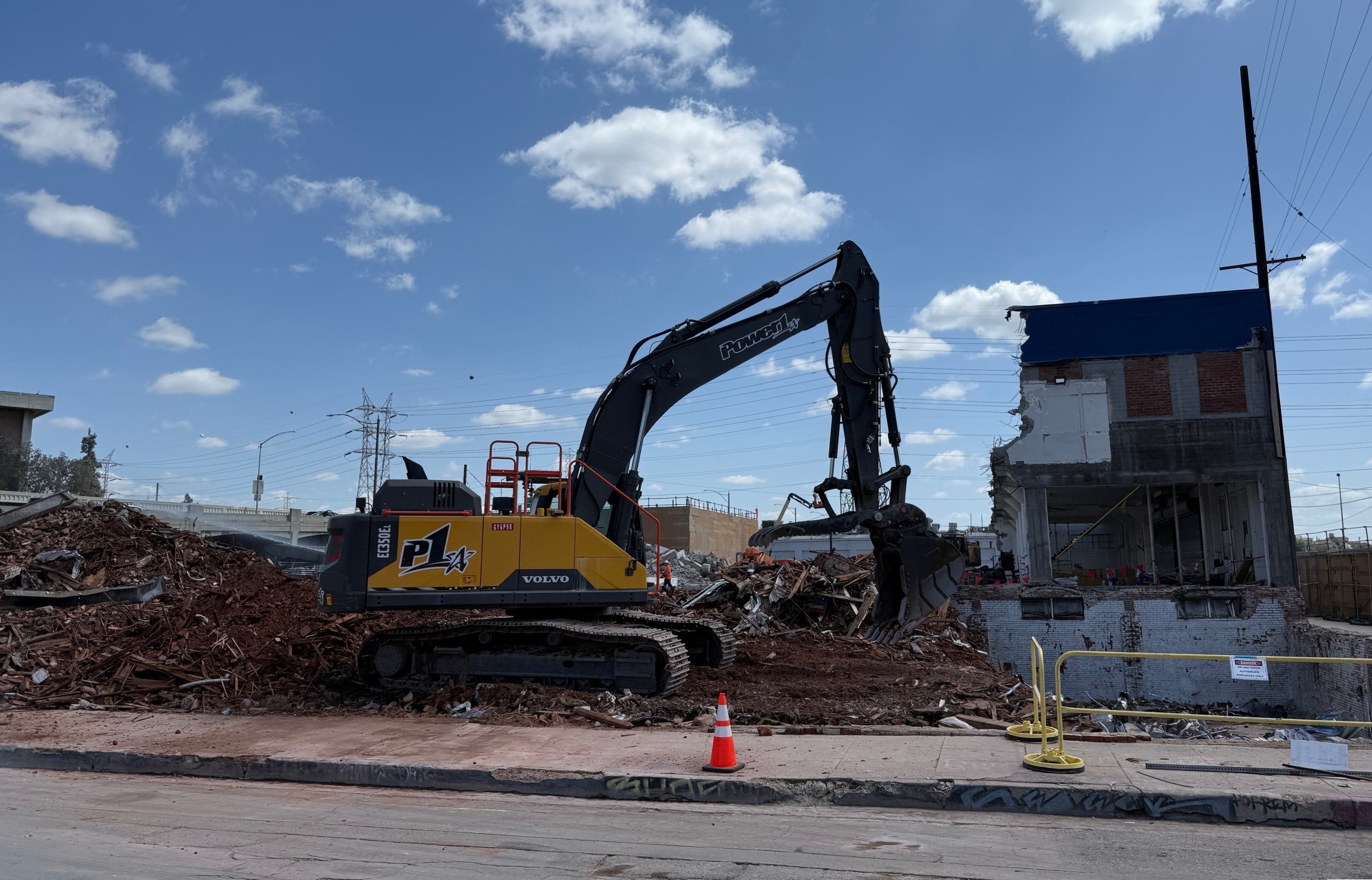
(Friends of Susana's have set up a ChipIn account to collect funds to help with medical bills. You can donate, here.)
By now you've probably heard the story.
Susanna Schick was bicycling down Spring Street in the green buffered bike lane on Friday night, when she was harassed by the driver of a white Lexus. After exchanging words, the car ran her down from behind, and left Schick lying in the street with broken ribs and a broken body.
Eventually, paramedics showed up and took her to the hospital and took her bike back to her house. Following a post by the intrepid Ted Rogers on Biking In L.A. that went viral, the media picked up the story. Schick's friend, Midnight Rida Jennifer Beatty, became a sort of spokesperson for family and friends controlling media access to Schick (except for one "intrepid" reporter for CBS2 that snuck past) and re-telling the story.
Sometime Monday morning, a reporter called the LAPD to get a statement. The police had no idea what they were talking about. Either the police were never called about the crash or didn't respond and the paperwork was lost. With Sgt. David Krumer, the LAPD's official liaison to the bike community on a vacation for Easter Weekend, there was nobody checking bicycling message boards or social media to learn about the crash.
This morning, again from Biking In L.A., comes word that the LAPD is treating this dangerous assault as a solo crash and not treating it as a potential felony crime. Rogers fumes that, "We may all be a lot less safe on the streets than we thought." Meanwhile, Don "Roadblock" Ward leads another group of cyclists to the Police Commission that oversees LAPD to make the case for safe streets, again.
Meanwhile, Schick remains in the hospital. According to Beatty and Ward, she'll be there for another couple of months, although her doctors are avoiding surgery if they can. She's coherent and talkative. Angry but controlled. Determined to see some good come of her tragedy.
Every time there's a high-profile crash, an agressive cyclist community has earned some sort of concession from the city. This time the city has a lot to make up for, and since the crash has become a sort of cause celeb, they would be best served to start making up now.
At the minimum, the LAPD should work with emergency responders to make certain their own response isn't hampered as badly as it was in this case and needs to rethink the way it handles bike crashes.
First, the city should adopt a policy that in the event of a downed cyclists with extensive injuries, the responders automatically contact LAPD before leaving the scene unless the cyclists' life is in danger. If it is, contact should happen as soon as it is safe to do so. It appears the paramedics' hearts were in the right place, how else can one explain them taking the time to return Schick's bicycle, but there needs to be procedures in place so that the police won't be so clueless about attempted vehicular homicide.
Second, the LAPD needs to create a system for investigating bicycle crashes that makes basic sense. In this case, Schick has repeatedly claimed that she was attacked by a car driver, but the LAPD is either downplaying or ignoring the car's involvement. One report is circulating unchallenged that the LAPD are treating the crash as a "solo bicycle" crash.
We don't have to take Schick's word on what happened. Because her family has possession of her bicycle (look for pictures to circulate later today) we have all the physical evidence that is needed to demonstrate that there was a hard collision between car and bicycle. Because she was in a bright green neon buffered bike lane, there is no rational way to pin the crash on Schick. In a phone interview last night, Beatty reported that the back of the bicycle was crumpled and that there was, "no way that could happen from a cyclist falling down."
This isn't the first time that the LAPD has ignored looking at a bicycle smashed from behind when determining a cyclist at fault in a life-endangering crash.
The LAPD's baffling testimony on the Andres Tena bike crash. Part II happening on a street near you.
In the 2009 case of Andres Tena, when a Hummer driver ran him down from behind, the LAPD reported that Tena "ran into an SUV" and that he could be responsible for damage to the vehicle's paint job. Unfortunately, by the time advocates' screams were heard by someone in power, Tena had already fixed his bike. He had no choice. He needed his bike to get from place to place.
Schick, whose injuries are more severe than Tena's, won't be needing her bicycle anytime soon and her loved ones aren't going to fix it until the truth is heard. Mangled bicycle and victim left lying in the street screams, "this was a hit and run crash." Such a crash would demand a full investigation. Lacking eye witnesses, a logical first place to start would be finding out who called the paramedics to let them know that Schick had been struck and was on the ground.
Even if the LAPD gets on its horse and starts working on tracking down the attacker and works with first responders to create a basic understanding of when LAPD needs to be notified in bike crashes, there is still a larger change that needs to happen. For years cyclists argued that LAPD doesn't seem to care about enforcing the law when cyclists are down. There's the this case, the Andres Tena case, the Christine Dahab/K-Town Ridazz case, the Ed Magos case, and countless others.
I clearly remember talking to a pair of teenagers at a Critical Mass "die-in" in 2009 who were wearing home made "LAPD HATES BIKES" t-shirts. I asked them about the shirts, and they laughed at me. The only time the LAPD takes bikes seriously is when they're busting up a group ride or harassing kids for not having the proper lighting and reflectors.
Things have gotten better in terms of group rides, but the department still seems clueless how to investigate a bike crash. It's time for the LAPD to officially promote and train a group of bicycle and pedestrian crash detectives who understand the laws of physics are different when all parties aren't protected by hundreds of pounds of metal and that any incident involving a car and people not in a car is potentially deadly no matter how minor it might appear to detectives who see crumpled cars on a near-daily basis. The mechanics of how these detectives would work between the different geographic divisions can be worked out later, but for now the LAPD needs to figure out how to effectively handle car vs. bike/ped crashes.






